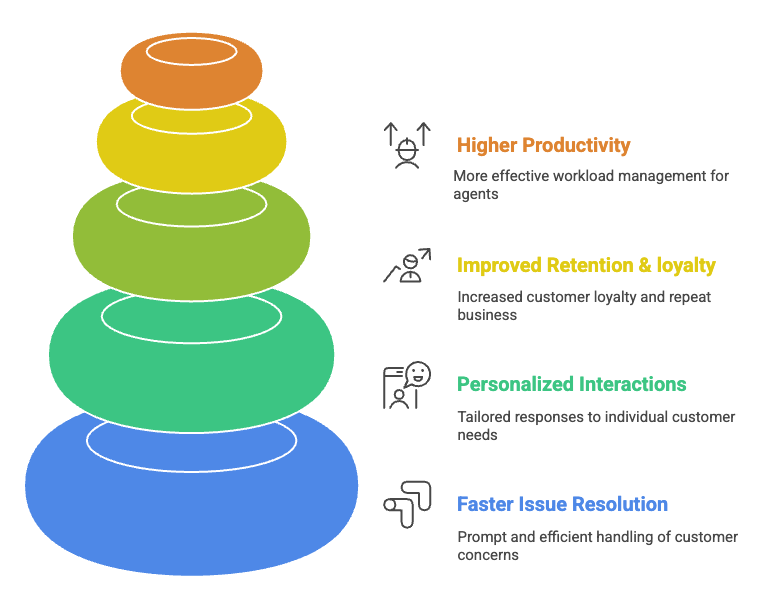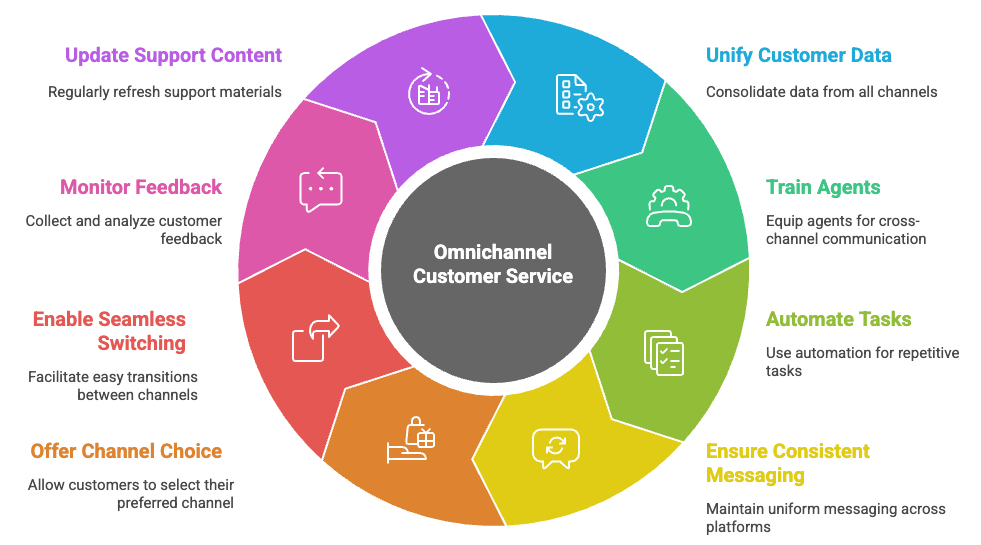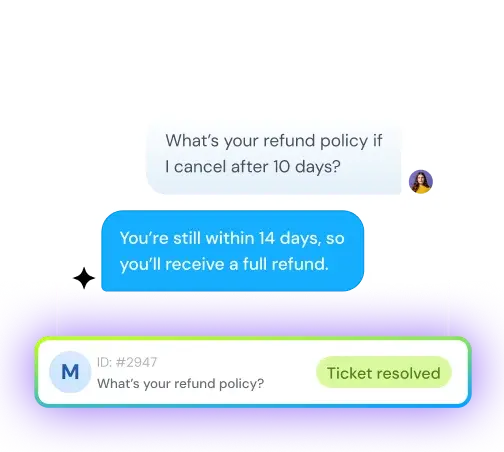8 Best omnichannel support practices to transform your customer service
Vaishali Jayaprakash
Sep 19, 2025

Customer experience matters more than ever to half of all customers. The competitive edge in today's digital world depends on how businesses handle omnichannel support.
Omnichannel support lets customers get help through their preferred channels. Unlike separate touchpoints, it creates a continuous experience by connecting all interactions. Customers can move between channels smoothly without repeating themselves or losing their conversation history.
Numbers tell the story clearly. Businesses with strong omnichannel customer service grow their revenue by 9.5% yearly. A positive service experience makes 89% of customers return for more purchases.
This piece shows you how to turn simple support into an exceptional omnichannel customer experience platform. You'll discover practical ways to bring your channels together, prepare your team, and track your progress effectively.
What is omnichannel support and why it matters
The digital era has changed how businesses interact with customers. Support systems have evolved from basic call centers into something more sophisticated: omnichannel support.
Definition of omnichannel customer service
Omnichannel customer service helps customers through a smooth, integrated network of devices and touchpoints. This approach maintains a consistent experience whatever communication channel customers use, unlike traditional support methods.
Omnichannel support connects all customer interactions into one continuous conversation. A support conversation can start on social media, continue through text messages, and end with a phone call—while keeping the full context throughout the trip. Customers don't have to repeat themselves when they switch channels.
Integration stands as the core principle of an omnichannel strategy. All channels—call centers, live chat, SMS, email, social media, and in-person interactions—work together in a single system. Support agents get a detailed view of each customer's history and can answer questions quickly.
How it differs from multichannel support
People often mix them up, but multichannel and omnichannel support are two completely different approaches to customer service.
Multichannel support means your business offers customer service on multiple channels. You might have a phone number, email address, and social media accounts for support. These channels usually work separately. They're like parallel roads that never meet—customers start over when they switch channels.
Here are the main differences between these approaches:
- Integration level: Multichannel systems use independent, unsynchronized channels. Omnichannel links all touchpoints for a smooth experience.
- Focus: Multichannel concentrates on the channels, while omnichannel puts customers first.
- Context preservation: Multichannel makes customers start fresh when switching channels. Omnichannel keeps the context with the customer.
- Data sharing: Omnichannel systems share customer information on all platforms for individual-specific interactions on any channel.
Omnichannel performs better than multichannel by a lot in customer satisfaction, with approximately 67% satisfaction scores compared to just 28% for multichannel solutions.
Why smooth experiences are now expected
Today's consumers see your business as one continuous trip. Every interaction shapes their view of your brand.
Several factors have changed these expectations:
Better technology lets businesses use more advanced support systems. So customers expect consistent experiences across multiple channels, with 90% wanting uniform interactions throughout their trip.
Customer behavior looks completely different now. Consumers use almost six touchpoints on average when dealing with businesses, and nearly 50% regularly use more than four. This shows a big change from 15 years ago when consumers used just two touchpoints.
The risks are bigger now. Smooth experiences aren't optional anymore—they're crucial for survival.
Almost 80% of American consumers value speed, convenience, knowledgeable help, and friendly service the most. Omnichannel support helps you meet these expectations and build stronger customer relationships.
4 Key benefits of omnichannel customer service
Companies that invest in omnichannel support see real returns throughout their operations. The benefits go way beyond simple convenience, from quick resolutions to satisfied customers.

1. Faster issue resolution
Customers hate waiting these days. Research shows that 60% of customers cite long wait times as their most frustrating service experience.
Omnichannel support cuts resolution times drastically by giving agents instant access to customer context. Customers don't need to repeat themselves when switching channels - a frustration point for one-third of customers.
Support teams can solve issues quickly by combining customer data from every touchpoint. This unified approach turns separate interactions into one continuous conversation thread that helps resolve issues faster with fewer callbacks.
2. Individual-specific customer interactions
Customer satisfaction depends heavily on personalization. Agents can view all customer interactions and conversations from a single dashboard with an omnichannel support platform. This complete view has:
- Complete purchase history
- Past interactions across all channels
- Browsing behavior
- Customer priorities
Agents can reference past issues or purchases that make customers feel valued and understood with this complete context.
3. Improved customer retention and loyalty
Customer retention presents the most compelling benefit of omnichannel support. Companies with strong omnichannel customer experiences retain 89% of their customers. Businesses with poor omnichannel strategies only keep about 33%.
An increase in customer retention rates can boost profits as well. This happens because omnichannel support builds trust through reliability and consistency.
Your business can stand out in competitive markets by offering excellent omnichannel customer service that matters to customers.
4. Higher agent productivity
Omnichannel support streamlines processes by a lot. It centralizes customer interactions and data so agents work in one system instead of multiple platforms.
Smart routing combines multiple communication channels into one routing engine that sends cases to the right service representative. This speeds up response times and resolutions while reducing agent stress.
Customer service representatives face lack of time as their biggest daily challenge. Omnichannel approach solves this by:
- Eliminating wasted time searching for information
- Letting agents handle multiple customers at once
- Automating repetitive tasks
- Using self-service options and AI-powered chatbots to set priorities
These efficiency gains let agents focus on complex issues needing human touch. Research indicates this increased productivity gives agents job satisfaction and reduces turnover.
8 Best practices to transform your omnichannel support
You need more than just technology to make omnichannel support work - it takes smart planning and hands-on execution. These eight best practices will change your customer service game.

1. Unify customer data across all channels
A combined view of customer information forms the backbone of great omnichannel support. Your team needs a central data system that connects all departments. This unified database lets agents see complete interaction histories no matter which channel the customer used before. Companies taking this approach show 91% greater year-over-year customer retention rates.
2. Train agents for cross-channel communication
Give your team the skills to handle many communication channels well. Start with one main channel, then add more as they get better. Let agents choose if they want to learn multiple channels - some make great single-channel experts. Teams stay confident through regular training as customer needs change.
3. Use automation to handle repetitive tasks
AI-powered chatbots can handle basic questions and free up human agents to tackle complex issues. These automation tools are a great way to get 24/7 support while cutting down agent workload. Smart routing systems connect customers with the right agents quickly.
4. Offer consistent messaging across platforms
Your brand needs clear voice guidelines to keep the same tone in all conversations. A central knowledge base helps all agents access information easily. Customers get similar answers whatever channel they use.
5. Let customers choose their preferred channel
Know where your customers spend their time. Look at which channels they use most. Customers avoid companies that don't support their favorite channels. Supporting customer priorities builds loyalty and saves money.
6. Enable seamless channel switching
Use tech that tracks customer touchpoints. This makes switching between channels smooth. Your team keeps the full conversation context so customers never repeat themselves.
7. Monitor and act on customer feedback
Get feedback from all channels to spot service gaps. Sort feedback by product performance, user experience, and technical issues. Keep track of customer satisfaction (CSAT), first contact resolution (FCR), and response times.
8. Regularly update your support content
Your knowledge base should grow with your products and services. Self-service options help customers who like solving problems on their own. Make support content available on every channel to create a truly unified experience.
Choosing the right omnichannel support platform
The right technology is the life-blood of good omnichannel customer service. You need a strategic plan to find the perfect platform that matches your needs from the many options available.
What to look for in a platform
Start by looking at your business needs and goals. You should spot your current problems like long wait times, disconnected data, or limited channel choices. Set clear targets about what you want your omnichannel platform to do.
Your platform choice must be able to grow with your business. It should adapt to new channels without causing major problems. The solution must combine smoothly with your existing tools such as CRM systems, e-commerce platforms, and social media.
Research the vendor's track record before you decide. Other businesses leave reviews on sites like G2 and Gartner that show how good their customer support really is.
Top features to prioritize
Beyond simple functions, some features make omnichannel support platforms truly stand out:
- Unified agent workspace – A single interface manages all customer interactions across chat, phone, email, and messaging apps
- Real-time collaboration tools – Features let support teams work together on complex issues
- Customer data centralization – A complete view of customer interactions and history on any channel
- AI-powered capabilities – Smart ticket routing, chatbots, and sentiment analysis improve efficiency
- Customization options – You can tailor workflows and dashboards to match your needs
The platform must have strong security measures that follow industry standards to keep customer information safe.
How to measure omnichannel support success
Measuring success accurately is the life-blood of any omnichannel support strategy. Your team can spot strengths, identify weaknesses, and boost customer service by tracking essential performance indicators.
Customer satisfaction (CSAT)
CSAT directly shows your customer's satisfaction levels after support team interactions. The measurement uses a scale of 1-5 or 1-10 to evaluate customer experience across touchpoints. Research proves that companies delivering strong omnichannel customer experiences maintain higher satisfaction scores.
First contact resolution (FCR)
FCR shows the percentage of customer issues solved in the original interaction. Most companies aim for a 75% industry standard. Each 1% improvement in FCR cuts operational costs by 1%. Companies with omnichannel strategies achieve a 31% reduction in first-resolution times.
Average resolution time (ART)
ART measures the total time needed to solve customer issues. The clock starts when customers reach out and stops once their problems get resolved. Omnichannel environments need ART measurements by channel. Response expectations range from minutes for live chat to several hours for email.
Net promoter score (NPS)
NPS evaluates customer loyalty through one simple question: "How likely are you to recommend our company?" Customer responses fall into three categories: promoters (9-10), passives (7-8), or detractors (0-6). The final NPS comes from subtracting the detractor percentage from promoter percentage.
Channel usage and volume
Understanding your customer's preferred channels gives vital insights into communication priorities. This information helps teams optimize resources and spot new service trends.
Key takeaways on omnichannel support
Omnichannel support helps businesses exceed modern customer expectations. This piece shows how an integrated approach creates continuous connections that build loyalty and improve revenue. True omnichannel support preserves context at every touchpoint, which eliminates frustration and speeds up resolution times - unlike disconnected multichannel systems.
The results are clear. Companies that use these strategies retain more customers, solve problems faster and have more productive support teams. Customers get individual-specific service without repeating information as they switch channels.
Your success depends on strategy and execution. Unite your customer data across platforms and train your team to handle cross-channel communication well. Let automation manage routine tasks so agents can focus on complex issues that need human attention. Give customers the freedom to choose their preferred channels while your message stays consistent throughout their experience.
The right platform creates the foundation of your omnichannel strategy. Search for solutions with unified workspaces, immediate collaboration tools and robust security features. Track your progress through key metrics like CSAT, FCR and NPS to find areas you can improve.
Note that customers see their interactions with your business as one continuous experience, not separate events. Your support strategy must adapt to this reality. Well-executed omnichannel support turns simple customer service into a competitive edge that builds lasting relationships and stimulates business growth.
Quick summary: 8 Best omnichannel support practices to transform your customer service
Omnichannel support has become essential in 2025, giving customers a seamless, connected experience across email, chat, phone, social, and more. Unlike multichannel, it integrates all touchpoints so customers don’t repeat themselves and agents see the full context.
Strong omnichannel strategies drive higher revenue growth (9.5% annually), customer retention (89%), and agent productivity, while cutting resolution times. The blog explains key benefits—faster issue resolution, personalization, loyalty, and efficiency—and outlines 8 best practices, including unifying customer data, training agents, using automation, offering consistent messaging, supporting preferred channels, enabling smooth switching, acting on feedback, and updating support content.
Choosing the right platform is critical: businesses should look for unified workspaces, AI features, security, and integration with existing systems. Measuring success with CSAT, FCR, ART, NPS, and channel usage helps optimize performance.
In conclusion, omnichannel support transforms customer service into a competitive advantage, building stronger relationships and boosting long-term growth.
Frequently Asked Questions
Omnichannel support means helping customers across all channels—email, chat, phone, social—while keeping their experience seamless and connected
Omnichannel means a unified approach where all communication channels work together, giving customers a consistent and integrated experience.
Multi-channel support lets customers reach you on different platforms, but each channel often works separately without a connected experience.
It’s called omnichannel because “omni” means “all”—it unifies all customer touchpoints into one smooth journey.
